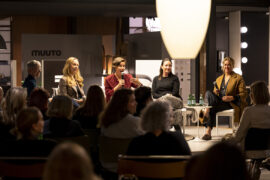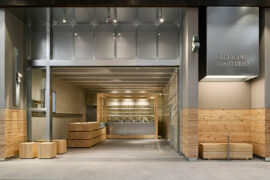Returning to Australia after 12 years abroad, architecture-interior designer Christine McKanna-Farr is bringing designmilkstudio to the Hunter Valley.

A recognised leader in design excellence, architect-interior designer Christine McKanna-Farr has a portfolio to be envied. Spanning hotels and resorts, luxury residential, strategic master planning and feasibility analysis, her focused is sharply on responsible design.
Key to her design platform is an astute understanding of adapting space via eco-friendly materials that are always conscience of environmental impact. Indeed, hers has been a stellar career across South East Asia, China, the Middle East and Australia, with firms such as DWP, Woods Bagot, M. Mosser and Associates and Kerry Hill AO in Singapore.

designmilkstudio director, Christine McKanna-Farr. Photo: Warren Marshall.
Returning to Australia after 12 years abroad, McKanna-Farr is bringing her particular proficiency to the Hunter Valley via designmilkstudio. Her timing could not be better with $12.7 billion earmarked for developing the local Newcastle economy over the next twenty years. Recent announcements include the $66 milllion International Airport Expansion fostering an estimated 850,000 additional visitors to the region.
McKanna-Farr: I visited the Hunter when my father had retired here, but I came here to live when I married Andrew Farr. His parents are from the land, and we decided to get back into the dairy industry, which is milk harvesting on a rather large scale (2500 acres). We have built that business for the last seven years while I’ve also been working in and out of Australia covering regions such as the Middle East, Saudi Arabia, South Asia, and back into Australia.
COVID changed everything with the Asia region closing, but we also needed to come back for our farming business which is a big commitment. I am driven by the environment, whether it’s the land we live on, or architecture and design, and being with people that want to create amazing things, whether here or overseas.
I think having the studio in the Hunter gives the opportunity for dialogue with the local community to know what I do and they can now see and visualise what I’m up to. Word of mouth in the rural regional community is huge: conversation, dialogue, discussion, it is no different to the discussions we used to have around kitchens, or when I was working with Kerry Hill. They are the deepest encounters with people that create new opportunities.
I’ve been working actively in the Hunter for nearly four years under the designmilkstudio umbrella and there’s been a couple of projects that have been bubbling along for years and it’s beautifully cascading: organically growing.

McKanna-Farr has been busy bringing designmilkstudio’s unique brand of luxe sustainability to Regional NSW with projects such as this stone bathroom retreat, designed for a residence in Kangaroo Valley.
The international airport will open more tourism opportunities in the region with new boutique resorts and residential projects on the boards. Really everything, from master-planning to domestic architecture, moving more toward a contemporary ideal. Not just in terms of aesthetic, but in terms of sustainability and lifestyle.
COVID means travel bubbles, initially between Singapore and Newcastle, Newcastle and New Zealand. It’s targeted: Singapore and Southeast Asia are already so intricately connected to Australian business. There is huge potential for the area as a whole.
I believe the connection between Singapore and Newcastle is significant. People need to campaign around this airport expansion as well as the Hunter Identity and Positioning Strategy to connect the dots. There is certainly room here for large-scale projects by developers with a regional vision as a gateway-magnet for discerning lifestyles.
Hunter tourism is highly populated with the Asian market from Sydney – Sydney is a longer drive, but if you fly straight into Newcastle, it’s literally 40 minutes into Pokolbin. Agriculture used to be thriving, but that has been reduced now because of the mines and how economies move forward with technology.
With boutique developments there are so many opportunities to connect to good food, the lifestyle, the mountains, escarpments and space, Singapore’s space is diminishing.
Most definitely… Yes, I have retained my offices in Malaysia and Singapore. So, keeping all the nodes of connection alive is amazing. So much opportunity. I’m sitting in the studio (on the property), doing my project work; I’m still connecting to the people that I need to connect with and employing staff in both Australia and Southeast Asia.
We’re exchanging so much information and it is a completely different climate in the Hunter, compared to Malaysia, where our rendering team is based. Rendering the Australian landscape is very different in light patterns, etc. It’s really just a time delay: we just have a lot of space between us.

designmilkstudio’s conscientious approach toward the environment and holistic definition of luxury has been honed through McKanna-Farr’s experience working in South East Asia on luxurious hospitality spaces, such as The Lalu Resort, while at Kerry Hill Architects. Photo: Albert Lim.
I think it is so fundamentally different. Gosh, it’s so different. Luxury in Asia is space and views. The way we design the space, and how we place our buildings and our pavilions in the space, that’s what is going to be enjoyed and embraced with what we have in Pokolbin and Newcastle.
More international operators coming in and focusing on running smaller boutique areas, such as The Shangrila group, having branched out into Zen, which is a boutique offering in the hospitality sector. You’ll find a lot of the big brands launching into smaller mini brands, boutique brands.
Sustainability is just a marketing term. 120 years ago, we were building buildings that were cross ventilated, had beautiful big verandas to make the buildings work in winter and summer, all the seasons we have in Australia.
Sustainability is really all about siting a building on the land to lessen our extreme weather impact. It’s about how the building opens into the landscape and how you envelope it into the landscaping- going 360 degrees to building they built hundreds of years ago, even in Asia.

Kerry Hill Architects’ The Lalu Hotel in Taiwan. Photo: Albert Lim.
I think luxury to me in my projects is about the connectivity to your environment but also, it’s the proportion of the planning and the building, so it’s not a decorative item, it’s not a material element. It is the plan. For me planning is everything and I learned that when I was with Kerry Hill. I’ve never forgotten it.
Well, it’s going be a lot more sophisticated. I think good design is for everyone- it’s about good planning. And if you have the urban migration and COVID migration with people coming from urban centres out into this area, they will bring that sophistication. People want the old-style building where they add contemporary elements, or they want to restore something that’s old and needs love and attention.
I think there’ll be a lot of properties that are very old and rundown that will be purchased and restored with elements of very contemporary architecture, so that we can retain some of our heritage in the regional areas.
INDESIGN is on instagram
Follow @indesignlive
A searchable and comprehensive guide for specifying leading products and their suppliers
Keep up to date with the latest and greatest from our industry BFF's!

The undeniable thread connecting Herman Miller and Knoll’s design legacies across the decades now finds its profound physical embodiment at MillerKnoll’s new Design Yard Archives.

Merging two hotel identities in one landmark development, Hotel Indigo and Holiday Inn Little Collins capture the spirit of Melbourne through Buchan’s narrative-driven design – elevated by GROHE’s signature craftsmanship.

London-based design duo Raw Edges have joined forces with Established & Sons and Tongue & Groove to introduce Wall to Wall – a hand-stained, “living collection” that transforms parquet flooring into a canvas of colour, pattern, and possibility.

Emily Moss, Brooke Lloyd, Juliette Arent Squadrito and Alexandra Ramundi joined Alice Blackwood at Living Edge’s stunning showroom to discuss a milestone approach to design.

Paul Conrad, Conrad Architects founding director, designs premium residential homes and developments in many of Melbourne’s best streets.
The internet never sleeps! Here's the stuff you might have missed

Hecker Guthrie brings a natural, material-led design to Green Cup’s new Chadstone store, pairing pine, steel and glass with a grab-and-go layout inspired by the brand’s fresh, organic ethos.

Former INDE Luminary LeAmon joins the Design Institute of Australia (DIA) following more than a decade as the inaugural Curator of Contemporary Design and Architecture at the National Gallery of Victoria (NGV).